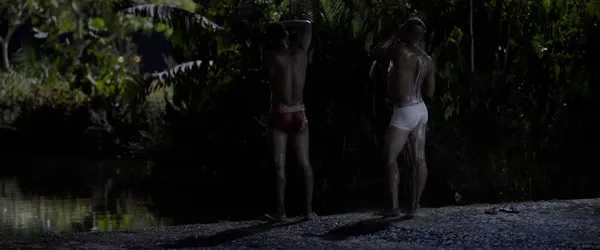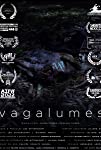Eye For Film >> Movies >> Fireflies (2021) Film Review
Fireflies
Reviewed by: Andrew Robertson

What is that blinking light upon the lamp? The camera's slow progress might be a drift across the field, a slow spin as with Wake In Fright. A landscape punctuated by posts punching skyward, a drone, a hum, a thing which resolves into layered organic chatter. They blink in pairs and patterns, until their flight begins a resolution like the slow emergence of ALIEN. Fireflies, more properly Vaga Lumes.
It is a slow progress, a statement. There are other examples but I am always minded of the sunrise of Silent Light, a virtue made of slowness, stillness. One echoed here. Not just the placid perambulation of a pair towards the river, an almost glacial progress to the bathing spot. Not just the drag past the night sky where a cell tower pushes past the treeline. The trolley's slow approach across the clearing.
The cats are attended to. Under sheltering boughs, past the rat and the mattresses, towards the benches and their benefactor. Through it all the brief lights in the darkness, movement within the dark. Leo Bittencourt's film is within Rio De Janeiro the Roberto Burle Marx garden within Flamengo Park.
These are outskirts though, not geographical but societal. This is an edge space, a transgressive one. Sexual encounters whose surreptitious nature is elided by prominent nudity, in a film where sound plays such a great part there are the noises of bodies wet and dry, exoskeletal and feline, soft and hard. Felipe Schultz Mussel's sound design adds layers to something meditative, hypnotic, the dreamlike space of the park at night.
In Q&A Bittencourt said that the first view had been to make a documentary in a more traditional style about the park through the day. As time passed everything in the day was left, leaving the "nocturnal". Two strands emerged, separately approached through months of research. The unhoused of the park and the cruising. He himself mentioned the ethical complexities, that they shot "largely with people they invited to the film". He discussed the artificiality of the park, that it is entirely upon reclaimed land. This then informed the film, "layers on top of the real", that the park itself is not identified until the end. To create a "non-place", to "abandon day for night", to create (or rather recreate) things that perhaps happened but did not happen in front of those cameras then.
He also discussed the artificiality of the sound, the park itself was built to accommodate an eight lane expressway so the traffic noise is inescapable. Unless, of course, the sound is removed and reproduced. Birds not native to the park, the elision of the actual, the automotive, to focus not just on the natural but the reconstruction of it. He told a story about the cruising scenes, that meters from their reproduction of the hook-ups there was to the side and the background the actual.
Also stating an intent to "Keep the spectator guessing what is the film's register", an opening scene with bathers is a product of a happy accident. Luck, of course, the secret currency of art, here in dialogue that would never go upon the page, an occupation of space where discussions of space are themselves complicated. Brasilia a constructed capital, but in Rio there have been equally engineered entities. Flamengo Park took the hills upon which existing neighbourhoods stood and used them to fill a bay, one that allowed a wealthier area connection to the centre of the city. The park is a consequence of that social engineering, a violence upon the body politic. From that comes further politicisation and privatisation of spaces, areas that are of the city and not of the city, a space for populations that are visible only by certain lights, by their chemistry. The fireflies eponymous.
There are other concessions to lighting. The opening lampposts are perhaps unique to the space, 40 meters tall. They give (to use a phrase of Bittencourt's) a "Hollywood moonlight", where the trees give shade that becomes the "dark part of the night". There was no additional light, it is placement of participants that create distinctions, framing. He told a story that as one first arrived in the park there came a moment where it seemed empty until the trees appeared to move, their bark melting. Life hiding in the shadows.
All of which is brilliant, undoubtedly. However for all its striking visuals this is context not given by the film. I can understand the choice to make the identity of the park an afterthought, to suggest a universality of its liminality much as, say, Liminality and Communitas. Yet to derive meaning from the artificiality of a place depicted with layered artificialities it helps to know that this is a place named after an architect of landscapes, that the displacement is not just artistic but political, evocative. How to give that grounding without giving ground to the air of the unreal is difficult, but to rely on a question and answer session (however useful) almost as long as the film itself isn't it. Without that context Fireflies is abstract, potentially uncomfortable, even intermittently visceral. With that framing it becomes something representative, potently uncompromising, even intermittently wonderful. The map is not the territory, of course, but Fireflies is weaker because it could do with a guide. Its mythic weight does not give it strength to operate without a legend.
Reviewed on: 26 Mar 2022
















